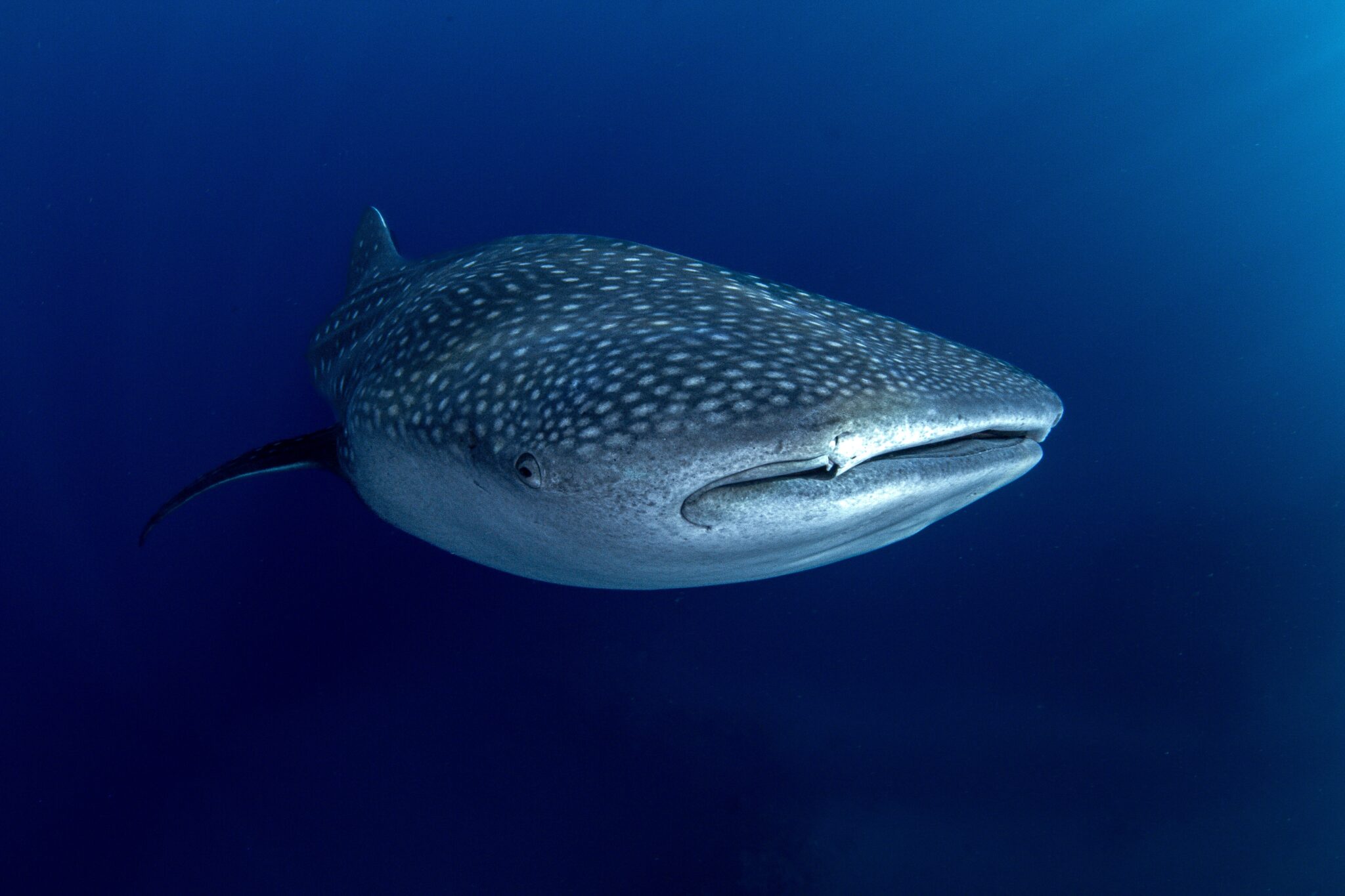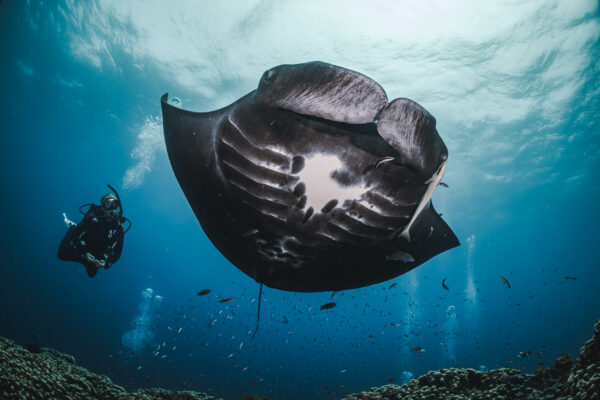With a third of all species threatened with extinction, sharks and rays are one of the most threatened groups of animals on the planet.
Governments and scientists often lack the resources to monitor shark and ray populations at the scale needed and therefore rely on fisheries reporting or regionalized scientific research that focuses only on one species or issue.
To combat this ocean emergency, PADI AWARE, in partnership with Blancpain – founding partner of PADI’s Blueprint for Ocean Action – is proud to introduce the Global Shark & Ray Census, a global citizen science program that aims to monitor shark and ray populations and to ensure they are protected from extinction.
This will be the world’s largest diver–led data collection program for sharks and rays, launching in 2026.
What Is the Global Shark & Ray Census?
Both divers and non-divers will be asked to collect sightings data on any shark and ray species they encounter, or to take part in monitoring specific sites to track population trends and submit their findings to our database. The sightings will be logged through the Conservation Action Portal (CAP). CAP is a powerful new digital platform from the PADI AWARE Foundation that streamlines data submission across all citizen science programs. It’s a one-stop shop for conservation action, making it easier than ever for PADI Divers, Professionals and Dive Centers to contribute meaningful data and engage in conservation directly through the dives they’re already leading.
To ensure scientific accuracy, PADI AWARE is partnering with James Cook University, a global leader in shark and ray research. The data will undergo rigorous scientific analysis and will be used to ensure that vulnerable species of sharks and rays have adequate protection, thereby supporting healthy populations and the dive industry. Globally, shark watching generates USD $314 million per year. By 2033, this is expected to double to more than USD $780 million per year.
The data from the Global Shark & Ray Census will:
- Show trends of shark and ray populations, so PADI Dive Centers can use scientific proof to advertise shark and ray-heavy dive sites.
- Help governments monitor and meet their shark protection commitments, which can increase tourism.
- Advance sustainable and responsible shark and ray tourism, helping to protect livelihoods and contribute toward local and national economies.
- Expand critical shark and ray habitat protection measures and contribute to the development of Marine Protected Areas (MPAs) to improve dive sites around the world.
It’s also important to note that a 2022 Reef-World survey revealed that divers are willing to pay more for dive adventures that give back to the ocean and operate sustainably.
Who Can Participate in the Global Shark & Ray Census?
Anyone in and on the water can contribute data to the Global Shark & Ray Census. Divers, snorkelers and even customers sitting on a boat topside can contribute to the census. Customers trained with you can use their new citizen science skills to help save sharks and rays around the world.
How Can PADI Professionals Get Involved?
The Global Shark & Ray Census is an opportunity to involve new and old divers in shark-related citizen science. Following the template of Dive Against Debris, anyone you take on or in the water can get involved in protecting sharks by logging the data into the CAP. The Global Shark & Ray Census, with its course component and citizen science component, offers many new opportunities for dive centers.
Get involved with the Global Shark & Ray Census to:
- Host exciting conservation dive activities
- Expand your customer base, both to divers and non-divers who want to take action
- Give your existing customer base new opportunities in conservation
- Identify priority species and areas for ongoing conservation efforts
- Advance critical research on local shark populations
- Help local governments meet their shark protection commitments
The census isn’t limited to saltwater divers; those in a freshwater environment can get excited about finding vulnerable species locally and even plan trips to see specific sharks and rays as well.
By embedding the Global Shark & Ray Census into your daily operations, you’re not only helping protect marine life — you’re future-proofing your business, inspiring divers and playing a pivotal role in advancing global ocean conservation.
The Revised AWARE Shark & Ray Conservation Specialty
Looking ahead, PADI AWARE is updating and revising the AWARE Shark & Ray Conservation Specialty course into a digital course. The most recent and up-to-date information on shark conservation will be incorporated, and the course will also include dedicated sections on sustainable shark tourism, the new citizen science program and details on how you can get involved in saving some of the most iconic species on the planet.
The revised AWARE Shark & Ray Conservation Specialty will take the action of the Global Shark & Ray Census and bring it to life within the PADI AWARE Conservation Action Portal. Following a similar structure to other PADI AWARE Specialty courses, this two-dive specialty will take divers deeper into understanding the threats sharks and rays face as well as highlight tangible actions divers can take to protect them.
The course will help change the narrative of misunderstood species, help document their presence in your local waters and then change the tide for sharks and rays. Together, we can create tangible local action to reduce the number of vulnerable shark and ray species threatened by extinction by 25%.
“By monitoring and understanding these species better, we can take targeted actions to ensure their survival and the health of our oceans.” – PADI AWARE Director, Danna Moore
PADI AWARE Will Continue Conservation Efforts by Protecting Species, Preserving Habitats & Advancing Research
The AWARE Foundation has a strong track record in citizen science. The Dive Against Debris program is the largest underwater citizen science database on the planet for marine debris, with more than 194,000 participants taking action. The data generated is used for ground-breaking research. With an estimated emergent market of almost a million shark and ray tourists, the Global Shark & Ray Census will provide everyone with the skills and tools to contribute directly to shark conservation efforts around the world.
Donate Today, Protect Sharks Tomorrow
Your support ensures the PADI AWARE Foundation can:
- Fund the Global Shark & Ray Census for the long-term
- Provide timely, reliable data for decision-makers
- Advocate for stronger protections worldwide
Founding Partner of the Global Shark & Ray Census
PADI is proud to work alongside Swiss prestige watchmaker, Blancpain, on the preservation of the underwater world. Thanks to Blancpain’s support of the Vulnerable Species Program, divers will be able to participate in the AWARE Global Shark & Ray Census, the largest underwater citizen science program designed to protect sharks and rays from extinction. PADI and Blancpain are collaborating on a long-term partnership aimed at increasing the number of marine protected areas (MPAs) around the globe. As a founding partner of PADI’s Blueprint for Ocean Action, Blancpain accelerated the creation of PADI’s MPA Program and its flagship citizen science program Adopt the Blue™.






